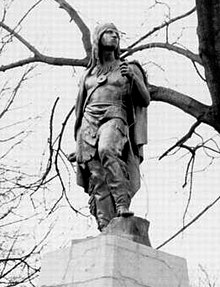Captain Pipe | |
|---|---|
| Hopocan, Konieschquanoheel | |
 Statue of Hopocan (Captain Pipe) in Barberton, Ohio | |
| Lenape, Wolf Clan leader | |
| Preceded by | Custaloga |
| Personal details | |
| Born | c. 1725? or 1740 |
| Died | c. 1818? |
| Relations | Uncle, Custaloga |
| Children | Son, Captain Pipe, and other children |
Captain Pipe (c. 1725? – c. 1818?) (Lenape), called Konieschquanoheel and also known as Hopocan in Lenape, was an 18th-century Head Peace chief of the Algonquian-speaking Lenape (Delaware) and War Chief 1778+.[1] He succeeded his maternal uncle Custaloga as chief by 1773.[2] Likely born in present-day Pennsylvania, he later migrated with his people into eastern Ohio.
Although Hopocan tried to stay neutral during the American Revolutionary War, after many of his family and people were killed in colonial American raids, he allied with the British. After the war, he moved his people fully into Ohio Country. He made treaties with the Continental Congress to try to protect Lenape land. American settlers continued to encroach on his people and territory.
In 1812 he moved with his people westward into present-day Indiana, where some accounts say he died. By 1821, most of the Lenape removed to Kansas, which was considered part of Indian Territory. They and other Native Americans were under pressure from the United States to remove from all areas east of the Mississippi River. Congress later formalized this policy under the Indian Removal Act of 1830, signed by President Andrew Jackson.
- ^ "1960.6934.01 - Document | Bartlesville Area History Museum".
- ^ Stephen T. Jackson, In History: The tale of Captain Pipe, Herald Bulletin, 4 September 2010, accessed 27 August 2021